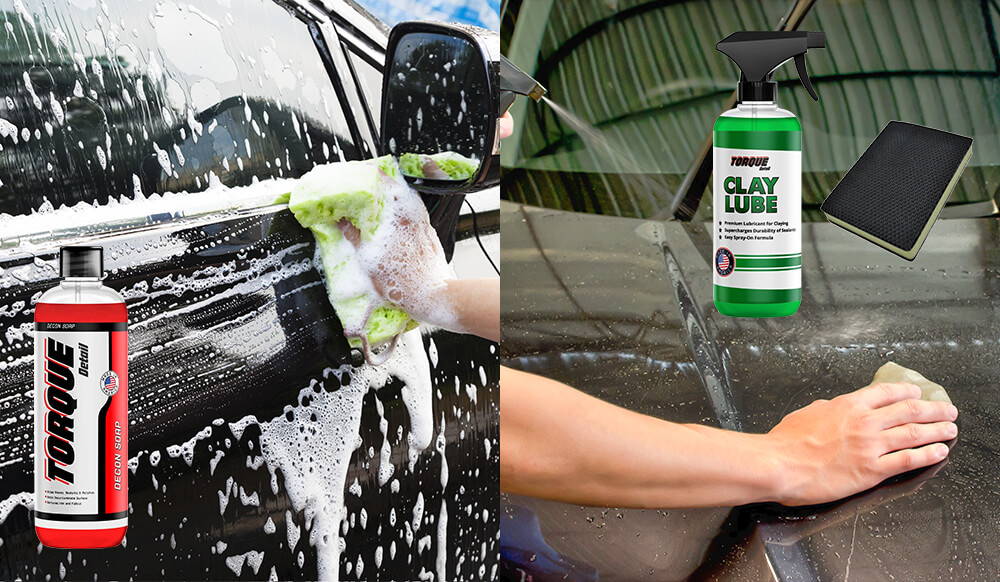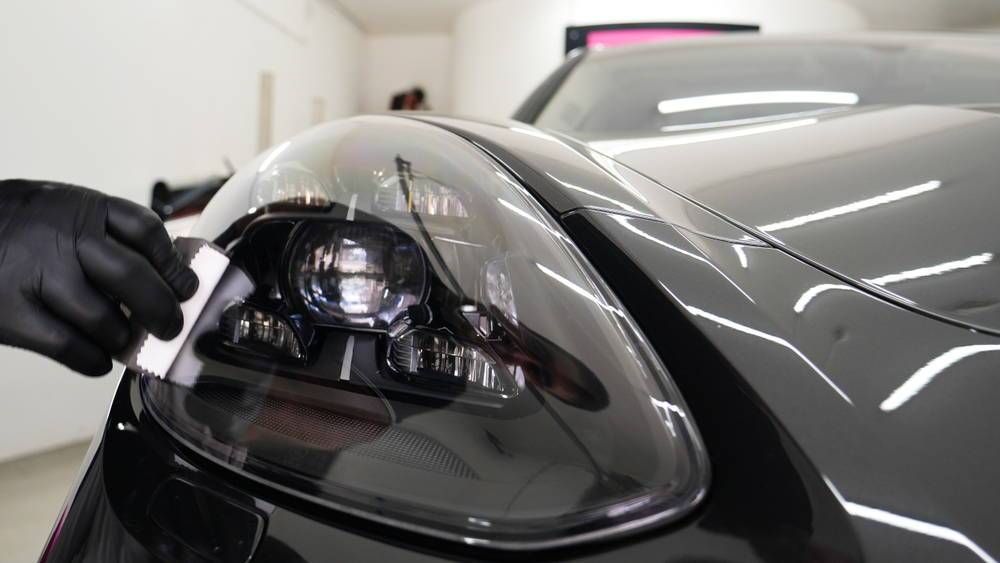Ceramic coatings are the best way to protect your vehicle’s paint from UV rays, acid rain, bird droppings, bug splatter, and a host of other contaminants. They produce a physical layer on top of the paint, repelling rain and water and preventing dirt and grime from sticking to the surface, producing a sort of self-cleaning effect.
One of the major benefits of ceramic coatings is they last a long time - usually a minimum of 12 months for the cheapest and lowest grade products.
But what if you want to remove a ceramic coating? Well, you’re in for a workout. Ceramic coatings are an absolute chore to remove.
In this article, we’ll walk you through the different methods of removing a ceramic coating from your vehicle.
Let’s get started and remove that old ceramic coating!
Why Would You Want To Remove A Ceramic Coating?
So you might be asking yourself: if ceramic coatings are so good, why would I want to take mine off?
In a perfect world, you’d drive your car to a detailing shop and order a full detailing service and a professional-grade ceramic coating. Such a service is definitely available - however, it costs several thousands of dollars, and unless you drive a very expensive vehicle it may not be in your budget.
If you drive a regular car like the rest of us, you’re probably winging your ceramic coating yourself - and that where the problems start.
Reason #1: A Bad Ceramic Coating Installation
Ceramic coating installation isn’t rocket science, but there’s more than one way to screw it up - especially if it’s your first time and you’re not really sure what you’re doing.
- The surface may not be perfectly clean and decontaminated
- You can apply too much or too little product and not properly spread it across the surface
- You can simply forget to wipe it off after it flashes
- You may not give the ceramic coating enough time to cure before driving off
These errors can cause a range of defects such as high spots, uneven thickness, trapped dirt and contaminants, hazing of the reflections, and overall poor finish and quality.
A bad ceramic coating application can’t really hurt your paint, but it can become ineffective at its job. It can also produce a horrible ugly finish that can easily drive you insane. The worst thing is, once it sets, you can’t simply wipe it off.
So, before you roll up your sleeves, check out these common ceramic coating fails.
Reason #2: A Failed Ceramic Coating
Ceramic coatings are not invincible. Even the most professional products that contain 90%+ SiO2 particles will eventually degrade and lose their qualities. Of course, cheaper or poorly installed products will wear down faster.
Here are the warning signs that your ceramic coating may be failing:
- Your car has started to lose its sheen
- The surfaces have lost their sleek, slippery feel and have become tacky
- You no longer see water bead off, and the surfaces remain wet
- More dirt and grime start accumulating on the body
If you observe any of the above, it may be a sign that your ceramic coating is no longer working. However, your car may just be dirty. Contrary to popular opinion, ceramic coatings can still get dirty. Try washing the car to see if the properties replenish. If not, it may be time to put a new coating on.
Reason #3: Deteriorated Condition
Ceramic coatings, just like your paint, can be scratched and scuffed. They are resistant to chemical attacks, UV rays, and water, but not mechanical erosion. The ceramic layer is only a few microns thick, so any scratches will most definitely penetrate into the clear coat or beyond.
If your car has gone through some scratches, dings, dents, or paint transfers, you may need some bodywork and paint correction. In such cases, the ceramic coating needs to be removed and reapplied after the body is restored.
Do You Always Have To Remove The Ceramic Coating Completely?
No, not always.
Perhaps there’s just one spot where hazing occurs or just a couple of scratches you want to polish off.
If the surface of the body panels is perfectly clear with great finish and shine, AND if the ceramic coating still exhibits all of its qualities, you don’t need to strip it down completely.
Instead, you can just remove it on the spots you want to the address and then reapply.
Conversely, there may be no paint issues to correct and the car still looks like a million bucks - it’s just that the coating is no longer working as it once was. It’s lost its hydrophobic properties, and you find the car is getting a lot dirtier a lot quicker than it used to.
In this case, you can simply apply a new coat of ceramic after thoroughly washing and decontaminating the vehicle. Ceramic coatings can be applied on top of each other. The layers are extremely thin and easily bond to one another, provided the vehicle is carefully prepped.
There’s a caveat, however: it’s only advised to apply a ceramic coating on an existing layer if they are the exact same product. Different formulations might not bond properly to each other, which will reduce the longevity of your coating, and you’ll then have to do it all over again sooner than normal.
Preparing The Car For Ceramic Coating Removal
Now then, if you definitely have to remove the ceramic coating, you need to start with a thorough cleaning and preparation session.
No matter how new, clean, or protected your car is, meticulous cleaning is always required. You’ll be surprised how much dust, dirt, airborne pollutants, and contamination there is on your car.
In order to properly remove a ceramic coating and subsequently apply a new layer, you need a surgically-clean vehicle.
Phase 1: Rinse The Vehicle
Rinse the car first to wash away all loose dirt and debris. Use light pressure to prevent propelling hard mud and debris at high speed toward the surface of your paint.
Phase 2: Decontamination
After rinsing, even if it looks like the car is perfectly clean, there’s going to be a number of particles still lodged in the surfaces and pores of the paint. We’re talking about mineral deposits, salts, iron dust, leftover grease and grime, tar, etc. There’s all kinds of contamination picked up from the surrounding environment.
Reminder: Every product you need to complete this step is bundled in our Ultimate Decon Kit.
Decon Soap is an all-in-one product that not only acts as a car shampoo, but also a contaminate remover. It’ll remove everything from your wax layer, all the way up to brake dust, grime, bug guts, iron, and more. If you did not use Decon Soap in the previous step, you’ll have to look for individual decontamination products. It might even be enough to get your ceramic coating off if it has degraded enough.
Finally, after chemically removing all possible contaminants, it’s time for a clay bar pass. Our Clay Decon Kit includes all you need to complete this step. Instead of a typical clay bar, we include a clay pad. It's a lot easier to use, more durable, and it can be used up to 100 times. A clay bar must be thrown out if you drop it on the ground. A clay pad can simply be washed off with the included clay lube and you're good to go!
No matter how many products you’ve used, there’s always going to be some stubborn stuff that has embedded itself within the actual layers of the paint. The clay bar will pick the majority of these bonded contaminants and leave the surface as close to perfect as can practically be achieved.
Remember to use lots of clay bar lubricant to keep the surface wet at all times while claying. Use light pressure and fold your clay over frequently to expose a fresh surface. Using a clay bar without a clay bar is like shaving without shaving cream. You need the lubrication to avoid causing damage.
Here's How To Remove A Ceramic Coating
A high-end nano coating (ceramic coating) really bonds to a vehicle's painted surface. This is completely different than wax. The above decontamination process works best if the coating has already started deteriorating. Otherwise, the below methods will be required.
Here are some more heavy duty and effective methods for removing the coating.
Testing the coating
The first step is to test the properties of the ceramic coating:
- Does it still exhibit hydrophobic properties?
- Is the surface slick and slippery to the touch?
- Are you seeing a change in the reflectivity and shine?
Typically, ceramic coatings cannot be removed through washing and are highly resistant to various chemicals. However, a low-quality or an old and deteriorated ceramic coating will be more susceptible to erosion.
If you went through all the cleaning and preparation steps meticulously, chances are you’ve already removed a portion of the ceramic coating and most definitely any wax or paint sealant that may have been applied. As soft as it seems, clay bars are actually abrasive, so in combination with other products, they may be able to strip away the coating.
If the coating is still holding strong, you need to start with the manufacturer's literature and check if there are any specific instructions for the coating’s removal process. This is important.
Method 1: Chemical removal of ceramic coatings
We mentioned already that ceramic coatings are very resistant to chemicals. However, that’s not entirely true in all cases. Ceramic coatings fare extremely well against acids and salts, which are the majority of chemicals the vehicle will encounter out in the environment.
However, on the opposite side of the pH scale, alkaline products such as degreasers will attack the ceramic coating aggressively and break down its bond with the surface, making it easier to remove. Even so, there’s a caveat.
WARNING: Your clear coat is just as vulnerable to alkaline products (degreasers, brake cleaners, etc.) as the ceramic coating is. If you use too strong a product or let it dwell on the surface, it can eat through the coating and attack the clear coat and underlying paint layers. If not used carefully and with utter attention, alkaline products can damage and compromise your paint irreversibly.
With that in mind, you can mix a DIY solution of wheel and brake cleaner diluted 5:1 with ordinary water. Mix thoroughly in a spray bottle and spray on the body panel.
While it’s still wet and soapy, pick up a new piece of clay and clay the surface, agitating the product. Make sure to work quickly and use light pressure. When you’re done, rinse thoroughly with a power washer.
In a 5:1 solution, the wheel cleaner should be fairly harmless to your paint. Still, you don’t want it on the surface a second longer than it needs to be. It’s always a good idea to test in an inconspicuous place first.
When you think you’re done, test the ceramic coating again to see how much you’ve removed. Watch the video below to see how it’s done.
Chemical removal is effective for old and degraded ceramic coatings, as well as for lower quality products that contain a smaller percentage of SiO2 particles. Professional-grade products, however, may not give in as easily.
Method 2: Polishing off ceramic coatings
The only universally accepted method to remove ceramic coatings is mechanical abrasion. Since the ceramic coating is a physical layer, polishing is the only surefire way to remove it 100% and expose the clear coat underneath.
In fact, many of the high-grade professional ceramic coatings claim the only way to remove them is through machine polishing.
If you’re removing the coating because of bad application, analyze the coating for high spots and abnormal thickness. If such are present, you want to wet sand them by hand before taking out the big gun.
Use fine sandpaper and a fair amount of lubricant on the surface. Start with 3000 grit and, if necessary, move down to more aggressive grit until you see the ceramic coating wearing off. Just be careful to not eat into the clear coat.
After all the high spots are addressed, the rest of the process is the same as polishing an uncoated vehicle.
- Grab your random-orbit machine polisher and equip it with a medium cutting pad and a medium to light polishing compound.
- Apply an appropriate amount of compound to the pad, following the product’s description.
- Dab the surface several times to spread the paste, and start the machine on the lowest setting to evenly apply it across the body panel.
- Then, switch to a higher setting and begin polishing. Move the machine approximately 1 inch per second. Don’t let it sit in the same spot to prevent overheating the area and marring the surface.
- Buff out the panel and inspect the result. Test the coating to see if it was completely removed.
- If you don’t like the result, you can step down to a more aggressive polishing compound. However, you will most likely need to perform a second pass with a lighter product to remove the scratches left by the previous operation.
- Polish the clear coat until you’re satisfied with the surface quality.
After polishing the vehicle, it should be 100% free of any ceramic coating.
Final prep before re-applying the new coating
You’re almost done.
Polishing can leave fine dust and other particles on the body panel. You’ll get most of this out when buffing the surface, but the nooks and crannies, especially on a more edgy car, will retain some amount.
Wash the car with regular soap one more time and dry thoroughly. As a final measure, do a final wipe-down with IPA - a 50/50 mix of isopropyl alcohol and water.
WARNING: Don’t use any waterless wash products before applying your new ceramic coating! Those can contain polymer sealants, synthetic waxes, and even some percentage of SiO2. While they work great for maintaining your car on a daily basis, they’ll prevent the ceramic coating from properly adhering to the surface of the clear coat, compromising its longevity and protective properties.
Summary
Okay, let’s quickly recap what we’ve learned.
You need to remove ceramic coatings when they:
- Have deteriorated and no longer exhibit hydrophobic or self-cleaning properties
- Were poorly installed and resulted in a bad finish
- Were low-quality to begin with and don’t perform as expected
Before removing a ceramic coating, you need to properly clean and prep the vehicle, which includes:
- Washing cycle using regular car soap and the two-bucket method
- Decontamination cycle using iron, tar, and mineral deposit removers as well as a clay bar
You can remove a ceramic coating by:
- Using the chemical method with a diluted alkaline solution and a clay bar - works effectively on lower grade or deteriorated coatings
- Using machine polishing to abrade the coating away - works effectively on all coatings
Alright, that’s certainly been a hassle. Removing ceramic coatings is a lot of work - and the better they are, the harder it is to take them off.
If you’re interested in an easier to use ceramic coating, why not try Ceramic Spray by TorqueDetail?
This is an easy-to-use spray ceramic coating that you can install in just a few minutes, and which provides a great level of protection against UV and chemicals. The easiest way to ceramic coat your vehicle and protect paintwork. Furthermore, Ceramic Spray gives your paint hydrophobic and self-cleaning properties. Finally, you get to enjoy an amazing shine and beautiful reflections.
And as an added benefit, if you ever want to remove it, it’s many times easier compared to a traditional ceramic coating.
Here’s to extending the life of our car’s paint!







